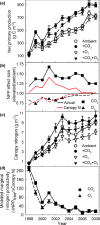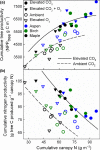Elevated carbon dioxide and ozone alter productivity and ecosystem carbon content in northern temperate forests
- PMID: 24604779
- PMCID: PMC4261895
- DOI: 10.1111/gcb.12564
Elevated carbon dioxide and ozone alter productivity and ecosystem carbon content in northern temperate forests
Abstract
Three young northern temperate forest communities in the north-central United States were exposed to factorial combinations of elevated carbon dioxide (CO2 ) and tropospheric ozone (O3 ) for 11 years. Here, we report results from an extensive sampling of plant biomass and soil conducted at the conclusion of the experiment that enabled us to estimate ecosystem carbon (C) content and cumulative net primary productivity (NPP). Elevated CO2 enhanced ecosystem C content by 11%, whereas elevated O3 decreased ecosystem C content by 9%. There was little variation in treatment effects on C content across communities and no meaningful interactions between CO2 and O3 . Treatment effects on ecosystem C content resulted primarily from changes in the near-surface mineral soil and tree C, particularly differences in woody tissues. Excluding the mineral soil, cumulative NPP was a strong predictor of ecosystem C content (r(2) = 0.96). Elevated CO2 enhanced cumulative NPP by 39%, a consequence of a 28% increase in canopy nitrogen (N) content (g N m(-2) ) and a 28% increase in N productivity (NPP/canopy N). In contrast, elevated O3 lowered NPP by 10% because of a 21% decrease in canopy N, but did not impact N productivity. Consequently, as the marginal impact of canopy N on NPP (∆NPP/∆N) decreased through time with further canopy development, the O3 effect on NPP dissipated. Within the mineral soil, there was less C in the top 0.1 m of soil under elevated O3 and less soil C from 0.1 to 0.2 m in depth under elevated CO2 . Overall, these results suggest that elevated CO2 may create a sustained increase in NPP, whereas the long-term effect of elevated O3 on NPP will be smaller than expected. However, changes in soil C are not well-understood and limit our ability to predict changes in ecosystem C content.
Keywords: air pollution; carbon sequestration; carbon storage; elevated carbon dioxide (CO2); free-air CO2 enrichment (FACE); net primary productivity (NPP); nitrogen; soil carbon.
© 2014 The Authors Global Change Biology Published by John Wiley & Sons Ltd.
Figures




References
-
- Ågren GI. Nitrogen productivity of some conifers. Canadian Journal of Forest Research. 1983;13:494–500.
-
- Ainsworth EA, Long SP. What have we learned from 15 years of free-air CO2 enrichment (FACE)? A meta-analytic review of the responses of photosynthesis, canopy properties and plant production to rising CO2. New Phytologist. 2005;165:351–372. - PubMed
-
- Ainsworth EA, Yendrek CR, Sitch S, Collins WJ, Emberson LD. The effects of tropospheric ozone on net primary productivity and implications for climate change. Annual Review of Plant Biology. 2012;63:637–661. - PubMed
-
- Ali AA, Medlyn BE, Crous KY, Reich PB. A trait-based ecosystem model suggests that long-term responsiveness to rising atmospheric CO2 concentration is greater in slow-growing than fast-growing plants. Functional Ecology. 2013;27:1011–1022.
-
- Bader MKF, Leuzinger S, Keel SG, Siegwolf RT, Hagedorn F, Schleppi P, Körner C. Central European hardwood trees in a high-CO2 future: synthesis of an 8-year forest canopy CO2 enrichment project. Journal of Ecology. 2013;101:1509–1519.
Publication types
MeSH terms
Substances
LinkOut - more resources
Full Text Sources
Other Literature Sources
Medical
Molecular Biology Databases

